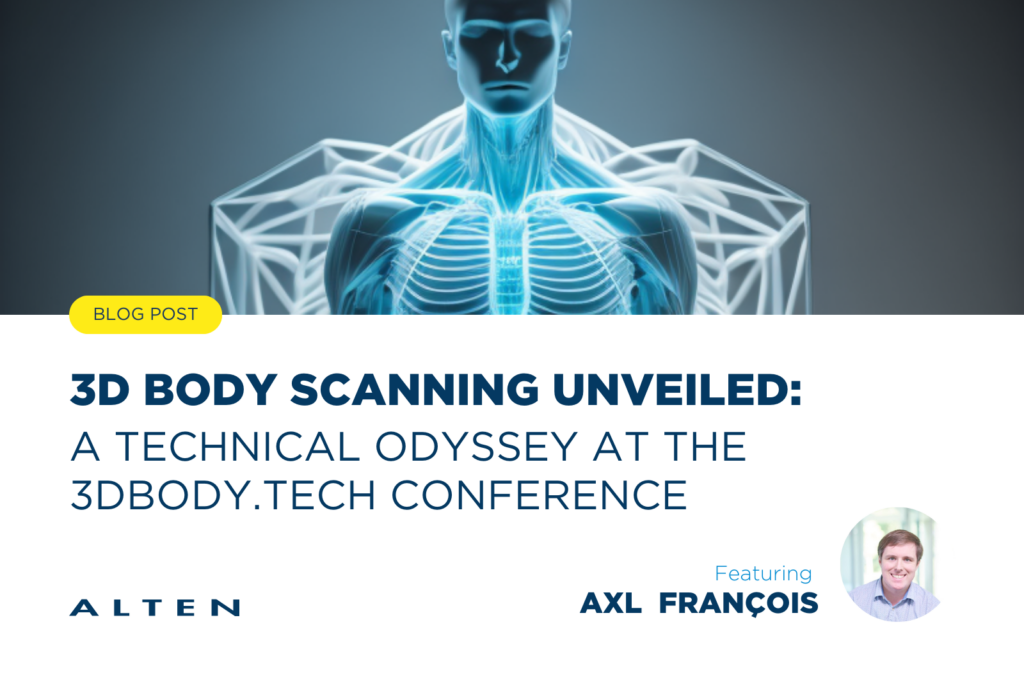3D Body Scanning Unveiled: A Technical Odyssey at the 3DBody.Tech Conference

One of our consultants recently embarked on a journey to the captivating city of Lugano, where he had the privilege of attending the 3DBody.Tech conference. This event was a full immersion into the world of 3D body scanning technology, offering a glimpse into its potential and the intricate challenges that come along.
Understanding 3D Body scanning:
3D body scanning is a technology that captures the three-dimensional shape and contours of the human body, creating a detailed digital representation or model.
I. Data Acquisition
3D body scanning utilises laser scanning, structured light scanning, depth sensors, photogrammetry, etc.
Laser scanners emit laser beams onto the body’s surface, measuring the distance to create a point cloud. The scanner calculates the exact distance between points on the body by analysing the time it takes for the laser to bounce back.
Structured light scanning involves projecting a known pattern or grid of light onto the body. As the pattern deforms over the body’s surface, cameras capture these distortions.
Depth sensors utilise infrared light or other depth-sensing mechanisms to measure the distance between different points on the body’s surface.

Photogrammetry, multiple images of the body from diverse angles, serve as the raw materials for a captivating 3D reconstruction. A specialised software meticulously analyses these images, identifying shared points in each photo. This process, rooted in the principles of triangulation, seamlessly weaves together a cohesive and accurate 3D model that vividly captures the intricate shape and dimensions of the human body.
RGB smartphone cameras can be used to capture images of people, which, when segmented, provide silhouettes for matching against a parametric human body model. In this way a 3D-reconstruction can happen based on 2D pictures.
II. Processing and Reconstruction
The collected data undergoes processing and reconstruction using specialised software, resulting in a digital 3D model that accurately represents the shape and dimensions of the scanned body.

III. Applications
Beyond the technical aspects, 3D body scanning has diverse applications in healthcare, fashion, gaming, research, and virtual communication.
- Healthcare: Within the healthcare sector, 3D body scanning technologies are instrumental in patient assessments, diagnostics, and ongoing monitoring. They provide valuable data for applications in fields like orthopaedics, dermatology, and prosthetics, and they are crucial for achieving “near ground truth” 3D shape accuracy in various healthcare applications.
- Apparel and Fashion: In the world of fashion, 3D body scanning revolutionises the way we shop for clothing. These technologies enable precise body measurements, tailored clothing recommendations, and virtual try-on experiences, enhancing the shopping journey and reducing the prevalence of ill-fitting garments.

- Gaming and Entertainment: The gaming and entertainment industry benefits from high-resolution avatars and virtual dressing rooms, creating immersive gaming experiences and lifelike digital characters. These technologies are essential for game and visual effects studios, enhancing user engagement and realism in virtual worlds.
- Research and Biomechanics: In the realm of research and biomechanics, 3D body scanning technologies are harnessed for their capacity to generate realistic human avatars, enriching studies in anthropology, biomechanics, and virtual simulations. They facilitate a deeper understanding of human anatomy, movement, and physiology.
- Virtual Communication and the Metaverse: With the growth of virtual communication and the metaverse, 3D body scanning technologies support the creation of photorealistic avatars. These avatars are pivotal in various digital communication scenarios, from virtual meetings to immersive gaming, revolutionising the way people connect in virtual environments.
Challenges?
Size advice, a complex chain
Delving into the realm of providing accurate size advice for ready-to-wear garments unveils a myriad of challenges that extend beyond sizing tables. Beyond the objective metrics, the unique ways in which individuals prefer their garments to fit introduce an element of personal choice that can vary widely. Balancing this subjective fit preference with the technical aspects of sizing becomes a delicate dance. Additionally, considerations extend to the complex interplay of fabric properties, such as stretch dynamics, manufacturing tolerances, potential shrinkage and the inherent size gap between adjacent sizes in relation to measurement accuracy, all of which contribute to the nuanced task of providing reliable and personalised sizing guidance. Navigating these multifaceted challenges demands a holistic approach that acknowledges both the objective measurements and the subjective preferences of consumers.
How to evaluate a scanning method?
Verifying the accuracy of 3D human body scans presents a multifaceted challenge, encompassing multiple issues. One major hurdle lies in the inherent dynamism of the human body, breathing patterns and the inability to maintain absolute stillness during scanning introduces pose variations that complicate the creation of precise human models. Furthermore, individuals may not conform neatly to parametric models, leading to discrepancies in representation. Technical challenges such as scanning errors and sensor inaccuracies further compound the issue, introducing further errors that must be addressed. Additionally, the potential for human error in the scanning process adds another layer of complexity to the quest for accuracy.

Digital avatars and their rights!?
In the digital era, actors encounter a challenge as their 3D-rendered likenesses are used without proper licensing, particularly in scenes where physical presence is unfeasible. The demand for licensing rights arises to address this issue, yet the rise of generative AI poses a threat by creating unauthorised digital avatars and animations. Advocates emphasise the necessity of regulating digital avatars, treating them as sensitive data, and granting individuals real-time control over their usage. Contrary to the persistent nature of digital personas on social media, a preference emerges for a non-persistent future, empowering individuals with greater control over their online avatars. This poses a challenge for the 3D body scanning industry, urging a re-evaluation of practices to align with evolving ethical and legal considerations.
>>> Read more about our IT services here <<<



